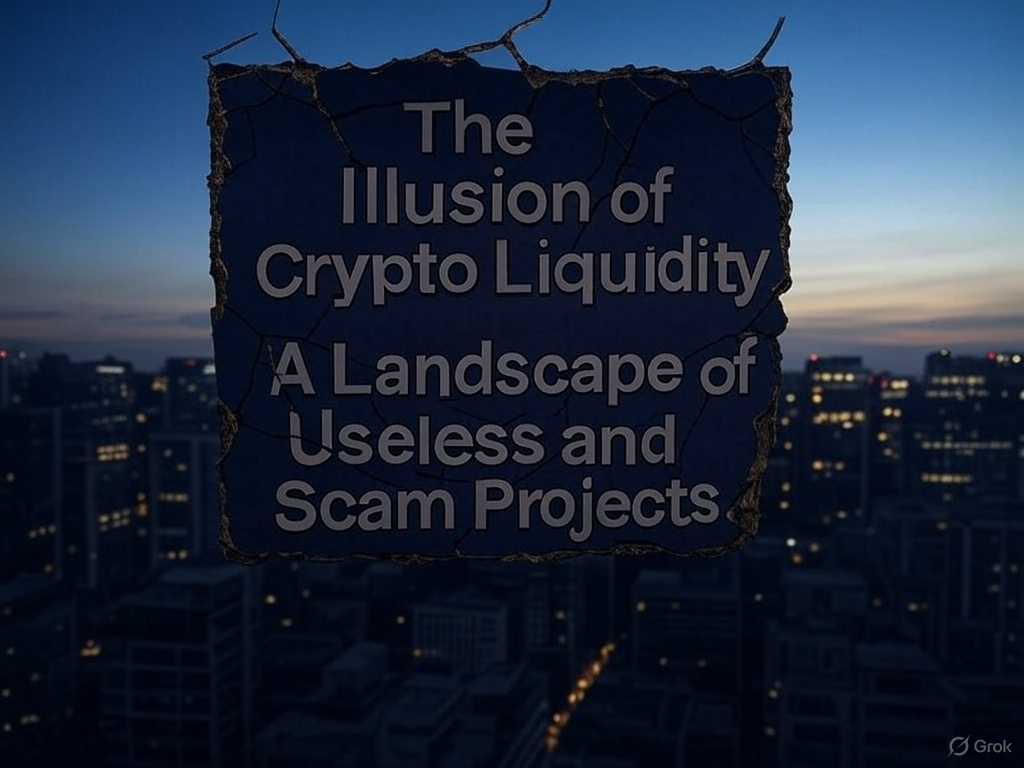Hello!
 The cryptocurrency market, once hailed as the future of finance, is teetering on the edge of a harsh reality check. Recent analyses and insider reports paint a grim picture: up to 90% of trading volume on major exchanges is fabricated, and an estimated 95% of crypto projects are either useless or outright scams.
The cryptocurrency market, once hailed as the future of finance, is teetering on the edge of a harsh reality check. Recent analyses and insider reports paint a grim picture: up to 90% of trading volume on major exchanges is fabricated, and an estimated 95% of crypto projects are either useless or outright scams.
As the façade of liquidity crumbles, the industry faces an inevitable reckoning that could reshape its future—or spell its downfall.
The Illusion of Liquidity
 Liquidity, the lifeblood of any financial market, refers to the ease with which assets can be bought or sold without drastically affecting prices. In crypto, liquidity has long been a selling point, with exchanges boasting billions in daily trading volume. But beneath the surface, much of this activity is an illusion.
Liquidity, the lifeblood of any financial market, refers to the ease with which assets can be bought or sold without drastically affecting prices. In crypto, liquidity has long been a selling point, with exchanges boasting billions in daily trading volume. But beneath the surface, much of this activity is an illusion.
Studies from firms like Bitwise and Chainalysis have revealed that wash trading — where bots or coordinated actors trade back and forth to inflate volumes — accounts for a staggering 70-90% of reported activity on many platforms. Even top-tier exchanges, often perceived as trustworthy, are not immune.
These inflated numbers create a false sense of market depth, luring retail investors into a trap where real liquidity is scarce.
The consequences are dire. Thin order books mean price manipulation is rampant, with “pump-and-dump” schemes thriving. A single large trade can trigger wild price swings, wiping out leveraged positions or trapping investors in illiquid markets. For institutional players, the lack of genuine liquidity makes crypto a risky bet, stalling mainstream adoption.
On topic:
- Lost Fortunes in Crypto Crashes: Money Laundering, Scams, Collusion, and a Horde of Fraudsters
- The 90% Collapse of the OM Token: A Harbinger of Thousands More to Come
A Landscape of Useless and Scam Projects
 If fake liquidity is the market’s dirty secret, the proliferation of worthless projects is its open wound. Of the thousands of cryptocurrencies listed on platforms like CoinMarketCap, an overwhelming majority — potentially 95%—offer no real utility or are outright fraudulent.
If fake liquidity is the market’s dirty secret, the proliferation of worthless projects is its open wound. Of the thousands of cryptocurrencies listed on platforms like CoinMarketCap, an overwhelming majority — potentially 95%—offer no real utility or are outright fraudulent.
The 2017-2018 ICO boom set the stage, with countless projects raising millions on vague whitepapers and empty promises. While some survived, most faded into obscurity or were exposed as scams.
Today, the cycle repeats with new guises: memecoins, NFT projects, and DeFi protocols that collapse under scrutiny. Many lack viable use cases, sustainable economics, or even basic transparency.
Scams are particularly rampant. Rug pulls, where developers abandon projects after draining funds, are common in DeFi. Fake tokens mimicking legitimate projects fleece unsuspecting investors. And phishing attacks, like those spoofing major exchanges, have cost users billions. The absence of regulation and accountability lets bad actors thrive, eroding trust in the space.
Warning Signs Everywhere
 Recent events underscore the market’s fragility. In early 2025, reports of massive liquidations—some estimate $8-10 billion in a single day—highlighted how quickly sentiment can shift.
Recent events underscore the market’s fragility. In early 2025, reports of massive liquidations—some estimate $8-10 billion in a single day—highlighted how quickly sentiment can shift.
High-profile hacks, like the $1.5 billion Bybit breach, exposed vulnerabilities in exchange security. Meanwhile, memecoins tied to fleeting trends crash as fast as they rise, leaving retail investors holding the bag.
Even Bitcoin, the market’s cornerstone, isn’t immune. While its price has soared past $75,000, analysts note that liquidity conditions, not fundamentals, often drive these surges. When central banks tighten monetary policy or global sentiment sours, Bitcoin’s demand wanes, dragging the broader market with it.
The Reckoning Approaches
The crypto market cannot sustain this house of cards forever.
 Several factors signal an impending shakeout:
Several factors signal an impending shakeout:
- Regulatory Crackdowns: Governments worldwide are tightening the screws. The U.S., EU, and others are drafting laws to curb wash trading, enforce KYC/AML compliance, and penalize fraudulent projects. Non-compliant exchanges and tokens risk being sidelined.
- Market Saturation: With thousands of tokens vying for attention, investor fatigue is setting in. Only projects with real utility—think Ethereum’s smart contracts or stablecoins for cross-border payments—are likely to survive.
- Liquidity Crunch: As fake volumes are exposed, exchanges relying on wash trading will lose credibility. Without genuine liquidity, they’ll struggle to attract real users, creating a death spiral.
- Investor Awakening: Retail traders, burned by scams and volatility, are growing wary. Institutional players, too, demand better infrastructure and transparency before committing serious capital.
The fallout could be brutal. A cascade of project failures, exchange collapses, and investor lawsuits may purge the market of its worst elements. But it could also clear the way for a leaner, more credible industry—if anything survives.
A Path Forward?
Not all is lost. A handful of projects and platforms show promise. Bitcoin, Ethereum and Quasacoin remain resilient, with real-world applications like decentralized finance, supply chain tracking, and remote work. Emerging exchanges prioritizing transparency, like those integrating on-chain settlement, could rebuild trust.
 And institutional liquidity providers, such as Nonco or even Citadel Securities, signal growing interest from traditional finance.
And institutional liquidity providers, such as Nonco or even Citadel Securities, signal growing interest from traditional finance.
For investors, caution is paramount. Stick to established assets, verify project fundamentals, and avoid platforms with suspiciously high volumes. Hardware wallets and strong security practices can shield against scams.
The crypto market’s current state—riddled with fake liquidity and scam projects—is unsustainable. A reckoning is coming, and it will separate the wheat from the chaff.
Whether this leads to a stronger, more mature industry or a prolonged winter depends on how the ecosystem responds. One thing is certain: the days of smoke and mirrors are numbered.
Thank you!
Subscribe to our newsletter! Join us on social networks!
See you!






